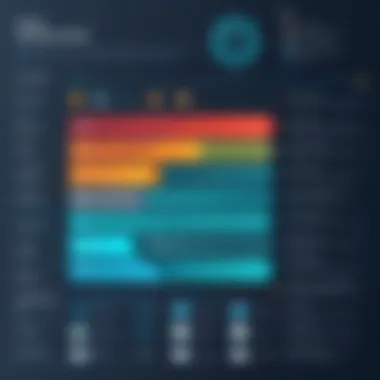Exploring Stata's Impact on Data Analysis Education


Intro
Stata remains a critical tool for data analysis, especially in professional and academic settings. Its pairing with online learning platforms, notably Coursera, creates a unique opportunity for users to access structured learning on this powerful software. This article delves into the functions of Stata as it integrates with Coursera to improve user skills in data analysis.
The role of Stata goes beyond traditional data manipulation. It includes a variety of statistical analytics, graphics, and data management capabilities. Coursera's online courses aim to help users harness these features efficiently, catering to varying levels of expertise from beginners to more advanced users.
By examining course structures and user experiences, we can find the true value of Stata's training within the context of a digital learning environment. This analysis will serve to inform professionals and businesses about enhancing their analytical competencies and staying relevant in an increasingly data-driven world.
Key Features and Benefits
Overview of Features
Stata offers numerous features that facilitate data analysis:
- Data management: Users can efficiently handle large datasets, enabling quick data loads and manipulations.
- Statistical analysis: Stata provides a wide range of statistical tests and models, including regression analysis and time series analysis.
- Graphics capabilities: Users can create high-quality graphs to visualize data easily.
- Programming: The software supports programming for custom tasks, enhancing flexibility for experienced users.
These features make Stata an invaluable resource for data analysis across various fields, including economics, biostatistics, and social sciences.
Benefits to Users
The integration of Stata with Coursera resonates with the needs of users:
- Structured Learning: Courses provide step-by-step learning paths that guide users through Stata's capabilities.
- Diverse Content: Users can find courses aimed at both beginners and advanced professionals.
- Accessibility: Coursera allows users to learn at their own pace, an essential feature for busy professionals.
"Stata's integration with Coursera allows professionals to enhance their analytical skills flexibly and effectively."
- Expert Instruction: Industry experts lead the courses, ensuring relevant and practical insights.
This combination results in a well-rounded approach to develop competence in data analysis using Stata.
Comparison with Alternatives
Head-to-Head Feature Analysis
When comparing Stata to other data analysis software like R and SPSS, some distinctions are clear. Unlike R, which requires significant programming knowledge, Stata is user-friendly for non-programmers. SPSS, while similarly accessible, often lacks some advanced features found in Stata that cater to more complex data manipulation.
Pricing Comparison
Stata operates on a licensing model, which, despite being a higher upfront cost compared to free alternatives like R, justifies itself through the comprehensive support and features that come with the software. Coursera offers courses at different price points, making learning more accessible compared to traditional in-class training. This aspect attracts a diverse set of learners who value flexibility and affordability.
Stata and Coursera, collectively, position themselves as crucial tools for IT and software professionals looking to improve their data analysis capabilities. Whether one's goal is career advancement or better understanding of data, the partnership is worth considering.
Understanding Stata
Stata is a powerful statistical software widely used in various fields like economics, sociology, and health sciences. Understanding Stata in the context of modern data analysis is paramount for professionals keen on enhancing their analytical skills and capabilities. Stata provides not just basic statistical functionalities but also advanced tools that allow for complex data manipulation and analysis. Its user-friendly interface combined with a robust command language enables researchers to handle substantial datasets efficiently.
Overview of Stata
Stata was developed in the early 1980s, designed explicitly for data analysis, management, and graphics. It has evolved over the years, offering an array of statistical techniques. Stata is particularly known for its capabilities in handling cross-sectional and longitudinal data. This makes it a preferred choice for researchers who deal with temporal data collection.


The software is structured to address the needs of various users, from new learners to seasoned statisticians. This adaptability signifies its relevance in a fast-paced, data-driven world. Various industries utilize Stata, including academia, government, and private sectors, demonstrating its versatility and importance.
Key Features of Stata
Stata includes many features that enhance its utility for users. Some notable characteristics are:
- Data Management: Stata allows for easy data import from various formats, such as Excel or CSV. It also offers data manipulation operations that simplify cleaning and reformatting.
- Statistical Analysis: Users can perform a range of analyses, including descriptive statistics, regression, and time series analysis.
- Graphing Capabilities: The software supports the creation of visually appealing graphs and charts, aiding in data interpretation.
- Extensibility: With its active user community, many packages are available to extend Stata's functionality.
- Documentation and Support: Stata’s manuals are extensive, while online forums provide additional help to users wanting to learn or troubleshoot.
This combination makes Stata a holistic tool for data analysis.
Applications of Stata in Data Analysis
Professionals use Stata in various analytical scenarios, which can include:
- Economic Studies: Researchers analyze economic data to draw insights into trends and forecasts.
- Public Health Research: Stata is often utilized to evaluate health outcomes and effectiveness of interventions.
- Social Research: It aids in examining social trends and problems through detailed surveys and datasets.
Stata empowers users to draw meaningful conclusions from their data, which is crucial for informed decision-making. As such, mastering Stata can significantly elevate one's skill set in data analysis, making it an essential tool for aspiring analysts.
Coursera and Its Educational Landscape
Coursera stands as a significant player in the realm of online education. It offers courses from renowned universities and institutions, making quality education accessible to a global audience. This platform enables learners to develop competencies and gain knowledge from the comfort of their homes. The importance of understanding this educational landscape cannot be understated for professionals looking to enhance their analytical skills using tools like Stata.
Coursera’s Role in Online Learning
Coursera provides a bridge between academic knowledge and practical skills. By partnering with leading universities, it fosters a comprehensive learning experience. Users can enroll in courses that cater to a range of skill sets, from beginner to advanced levels. This flexibility enables individuals to choose a learning path that aligns best with their goals.
Moreover, Coursera’s interactive features, such as discussion forums and peer reviews, facilitate a more engaged learning process. Users can share insights and clarify doubts, thus fostering a sense of community among learners. This engagement enhances retention and understanding of complex material, such as data analysis using Stata.
Impact of Online Education on Skill Development
The rise of online education has fundamentally reshaped how professionals acquire skills. With platforms like Coursera, learners have the opportunity to gain specialized knowledge in highly relevant fields, such as data analysis.
- Accessibility: Online platforms eliminate geographical barriers. Individuals can learn from anywhere, at any time, making education more inclusive.
- Variety of Courses: Learners can explore various subjects beyond their immediate field, expanding their knowledge base. This diversity is crucial in today's fast-evolving job market.
- Personalized Learning: Online courses often allow learners to progress at their own pace. This adaptability enables individuals to better grasp challenging concepts without the pressure of traditional classroom settings.
- Cost Effectiveness: Many online courses are more affordable than traditional degrees. This cost efficiency makes it possible for a wider audience to develop applicable skills.
The transformation in skill development through these platforms has significant implications for professionals pursuing advanced data analysis skills with tools like Stata. Online learning prepares individuals for real-world challenges, keeping pace with industry standards. This relevance is why coursera is essential for those aiming to excel in data-driven roles.
"The future of work requires an adaptable skillset, and online education platforms provide the necessary tools to develop these skills effectively."
Stata Courses Available on Coursera
Stata courses on Coursera play a crucial role in the landscape of modern data analysis. They provide learners with accessible training on a software that is widely used in academia, healthcare, and industries where statistical analysis is pivotal. Engaging with these courses offers distinct benefits such as a structured learning path, expert instruction, and a flexible schedule.
Users can explore varied course options that cater to different skill levels, from beginners to more advanced users. The structured approach helps learners gain a strong foundational understanding of Stata's functionality and application in real-world scenarios. The content is tailored to promote practical skills that translate directly into workplace capabilities.
Overview of Stata Courses
Stata courses on Coursera address a spectrum of topics necessary for effective data analysis. Covering everything from beginner tutorials to advanced techniques, these courses are designed with user needs in mind. For instance, an introductory course may focus on basic data management skills, while advanced courses might delve into sophisticated statistical modeling and analytics.
Most courses integrate hands-on projects that encourage practical engagement with Stata. This interactive model reinforces learning, allowing users to apply their skills immediately. Learners can expect a mix of video lectures, reading materials, and collaborative exercises. This variety caters to different learning styles and promotes a comprehensive understanding of the software.


Course Structure and Content
The structure of Stata courses on Coursera typically includes several key components:
- Modules: Each course is broken into manageable modules, often including video lectures, assignments, and quizzes.
- Hands-On Projects: Many courses require the submission of practical projects that apply the skills learned.
- Peer Interaction: Some courses offer discussion forums where learners can share insights, ask questions, and collaborate with others.
- Assessments: Regular assessments gauge learner progress and ensure understanding of the material.
This design ensures that learners not only consume information but also engage with it actively, fostering a deeper comprehension of Stata.
Prerequisites for Stata Courses
Before enrolling in a Stata course on Coursera, it is important to consider prerequisites. While many introductory courses welcome all learners, advanced courses often assume a certain level of familiarity with statistical concepts and other software tools. General prerequisites often include:
- Basic Statistics Knowledge: Understanding fundamental statistical concepts is crucial for making the most of Stata tools.
- Computer Proficiency: Familiarity with general computer software operations significantly helps.
- Recommended Software Practice: Some courses may suggest prior exposure to Stata or similar statistical software.
Meeting these prerequisits ensures that learners can fully engage with course material, enhancing their learning experience.
User Experiences with Stata on Coursera
User experiences are central to understanding the effectiveness and impact of learning Stata on Coursera. These experiences can encompass a range of insights from learner satisfaction to practical results achieved post-training. They serve not only as feedback on the courses themselves but also provide valuable information for prospective learners contemplating their decision. This section will delve into the feedback from learners and the case studies of individuals who have successfully integrated Stata into their professional life, illustrating the transformative power of effective learning with this software.
Feedback from Learners
Feedback from learners forms a critical component in evaluating any educational course. With regarding to Stata on Coursera, this feedback often highlights several key aspects:
- Course Quality: Many users praise the intuitiveness of the course content. They find that the structure helps in understanding the complexities of Stata without feeling overwhelmed.
- Support and Resources: Several learners note the availability of supplementary resources, including forums and peer discussions. This community support enhances the learning experience.
- Skill Application: Learners frequently report feeling better equipped to handle real-world data analysis tasks after completing their courses. They emphasize the direct applicability of their newly acquired skills to their jobs or projects.
One common sentiment among users is how Coursera's flexibility allows individuals to learn at their own pace. "I appreciate being able to revisit concepts as needed," one user mentioned. This aspect of the learning environment proves to be beneficial, especially for busy professionals.
The integration of assessments and projects within these courses often receives positive feedback too. These practical assignments enable users to apply what they learned in a controlled environment before using it in their work settings. Learners have expressed increased confidence in their ability to use Stata after engaging in these hands-on activities.
Case Studies of Successful Stata Users
Examining specific cases of successful Stata users provides illuminating insights into how effective the courses can be. For instance, one notable case involves a data analyst at a healthcare organization who took a Stata course to improve her data management skills.
After completing the course, she was able to streamline her data collection and reporting processes significantly. "Before this course, I was relying on Excel for analysis. Now, I use Stata for everything, and it saves me so much time," she reflected. Her experience underscores the practical benefits that the courses can impart.
Another instance is of a social scientist working on a government project. His course in statistical modeling helped him refine his research methods, leading to better outcomes in his studies. The skills he gained not only advanced his career but also allowed his team to publish more impactful papers. "Stata transformed my approach to analysis, and now our results are more robust than ever," he commented.
In summary, user experiences with Stata on Coursera offer valuable evidence on the practical effectiveness of these education resources. The feedback emphasizes course quality, support systems, and skill applicability, while the case studies provide tangible examples of success that inspire and motivate future learners.
Practical Skills Gained from Stata Courses
Gaining practical skills from Stata courses on Coursera is crucial for anyone seeking to enhance their data analysis abilities. This part of the article examines specific elements that are integral to the learning experience while discussing the benefits and considerations of these practical skills.
Data Management and Analysis Techniques
Data management is foundational in statistical analysis. Stata courses teach users how to manage datasets effectively. Participants learn how to import data from various formats, how to clean and prepare it for analysis, and how to handle missing values. The techniques include using commands to filter, sort, and reshape data. With hands-on exercises, users grasp the concepts better. Furthermore, understanding these techniques allows for more efficient data handling, leading to more accurate analysis.
Statistical Modeling with Stata


Statistical modeling is a core component of data analysis. Stata courses guide students through constructing and interpreting various statistical models, such as regression analysis. Learners explore different types of models based on their specific datasets and research questions. The course emphasizes understanding assumptions behind models and how to validate results. Mastering these techniques empowers individuals to make informed decisions based on data trends.
Visualization and Reporting Skills
Being able to report findings is as vital as the analysis itself. Stata offers various options for data visualization. Courses provide guidance on creating graphs and charts that effectively communicate insights. Learners discover techniques for designing clear and impactful reports. Understanding the importance of visual representation helps in conveying complex information in a digestible format. Mastery in this area can greatly enhance professional presentations and the interpretation of data among stakeholders.
"The ability to visualize data is key in making informed decisions. It is about bringing data to life and telling a story."
The Future of Learning Stata
The future of learning Stata is intricately linked to the evolving landscape of data analysis and the increasing reliance on digital platforms. As the demand for data-driven decision making continues to rise, understanding how to leverage tools like Stata becomes paramount. Stata not only equips users with necessary technical skills but also enhances their capability to interpret and present data in a meaningful way.
In this digital era, it's essential to focus on the role of personalized learning and how that shapes the ways individuals and organizations approach data analysis. Continuously adapting Stata education to meet these emerging needs will be crucial for both learners and educators.
Emerging Trends in Data Analysis Education
Recent years have witnessed significant shifts in data analysis education, driven by technological advancements and changes in learner expectations. Online platforms like Coursera are at the forefront of this transformation, making education more accessible and flexible. Some trends in this realm include:
- Blended Learning Approaches: Combining online resources with traditional methods promotes a more interactive and engaging learning experience. This method often results in better retention of knowledge.
- Microlearning: Short, focused segments of learning material are easier to digest. This trend suits the busy schedules of professionals looking to acquire new skills efficiently.
- Data Literacy Emphasis: There is a growing recognition of the need for data literacy across various industries, not just among data specialists. Courses are becoming increasingly tailored to meet this demand.
This shift to data literacy results in more informed decision-making across all levels of management.
- Collaboration and Community Learning: Learners often benefit from engaging with peers and experts in the field. Forums and discussion threads enhance the learning experience, allowing participants to share insights and solve problems together.
Adapting to Changes in Technology
The rapidly changing technological landscape necessitates that Stata courses remain adaptable. This is not merely a matter of updating materials; it involves a fundamental shift in teaching methodologies as well. Several considerations exist in adapting to these technological changes:
- Integration of Artificial Intelligence: AI tools can provide learners with tailored experiences, identifying areas for improvement and adjusting the learning path accordingly.
- Enhanced Data Visualization Tools: With the importance of visual storytelling in data, Stata courses are incorporating advanced visualization techniques to help convey complex information clearly.
- Emphasis on Real-World Applications: Curriculum updates focus on practical applications, using case studies and real datasets to make learning relevant and impactful.
- Mobile Learning Platforms: As mobile technology becomes ubiquitous, learning Stata on-the-go is increasingly possible. This flexibility can broaden access, allowing a diverse audience to engage with data analysis concepts.
Through these adaptations, the future of learning Stata promises a more enriched educational experience, ensuring that users not only learn to operate the tool but also integrate it effectively into their analytical workflows.
Ending
The conclusion serves as a vital component of this article, encapsulating the significance of Stata in the current analytical landscape. As organizations increasingly rely on data to inform decisions, proficiency in data analysis tools like Stata becomes essential. The ability to manipulate, analyze, and visualize data directly translates into actionable insights, enabling professionals to remain competitive in their fields.
The Importance of Stata in the Analytical Landscape
Stata remains central to modern data analysis due to its robust features and user-friendly interface. It empowers researchers and analysts to efficiently handle complex datasets. Its statistical capabilities allow for an extensive range of analyses. This includes everything from basic descriptive statistics to intricate multivariate modeling. Stata’s comprehensive documentation also aids users in mastering its functionalities, ensuring that even beginners can quickly become proficient.
Moreover, its application spans various fields, such as economics, sociology, and biostatistics. This versatility enhances its appeal among a diverse set of professionals. The learning curve, while manageable, urges users to continuously improve their skill sets to utilize Stata to its fullest potential. Through consistent use and exploration of its features, users can develop a strong analytical acumen that fosters informed decision-making.
The Value of Courses on Coursera
Courses available on Coursera provide crucial insights into Stata's functionalities. They deliver structured learning experiences that cater to both novice and advanced users. Engaging with coursework designed by industry experts ensures that learners gain current knowledge relevant to practical scenarios.
The framework of these courses typically includes:
- Interactive Content: Many courses leverage quizzes and hands-on projects to reinforce learning.
- Expert Guidance: Users benefit from the insights of instructors who have real-world experience with Stata.
- Flexible Learning: As online courses, they allow participants to study at their own pace, making it easier to integrate education into their busy lives.
The value of pursuing Stata courses on a platform like Coursera extends beyond mere technical skills. It builds confidence in users and equips them with the resources needed to tackle real-world data challenges effectively. Overall, a commitment to learning Stata through these courses can lead to enhanced career trajectories in data-centric roles.
"In the era of data-driven decision making, mastering tools like Stata is not just an advantage; it is a necessity for informed leadership and insight generation."
In summary, the importance of Stata and the valuable training opportunities on Coursera cannot be overstated. Together, they present a pathway towards enhanced analytical capabilities and informed decision-making.



